University Financial Accounting and Reporting 2 Team Memo
VerifiedAdded on 2023/06/07
|10
|2112
|466
Report
AI Summary
This document is a comprehensive financial accounting memorandum prepared for the board of directors of Telstra Corporation, analyzing the technical aspects of consolidation. The memo delves into key areas such as non-controlling interest, explaining its nature and representation in financial statements, referencing Telstra's annual report. It then examines goodwill, defining it and discussing its implications in mergers and acquisitions, again referencing Telstra's acquisitions and impairment testing. The memo also covers intra-group transactions and balances, emphasizing their elimination during consolidation. Finally, it addresses accounting for foreign subsidiary companies, detailing the temporal accounting method and translation of financial statement items. The memo utilizes Telstra's 2017 annual report to illustrate these concepts and provide specific examples, offering a practical application of accounting principles.
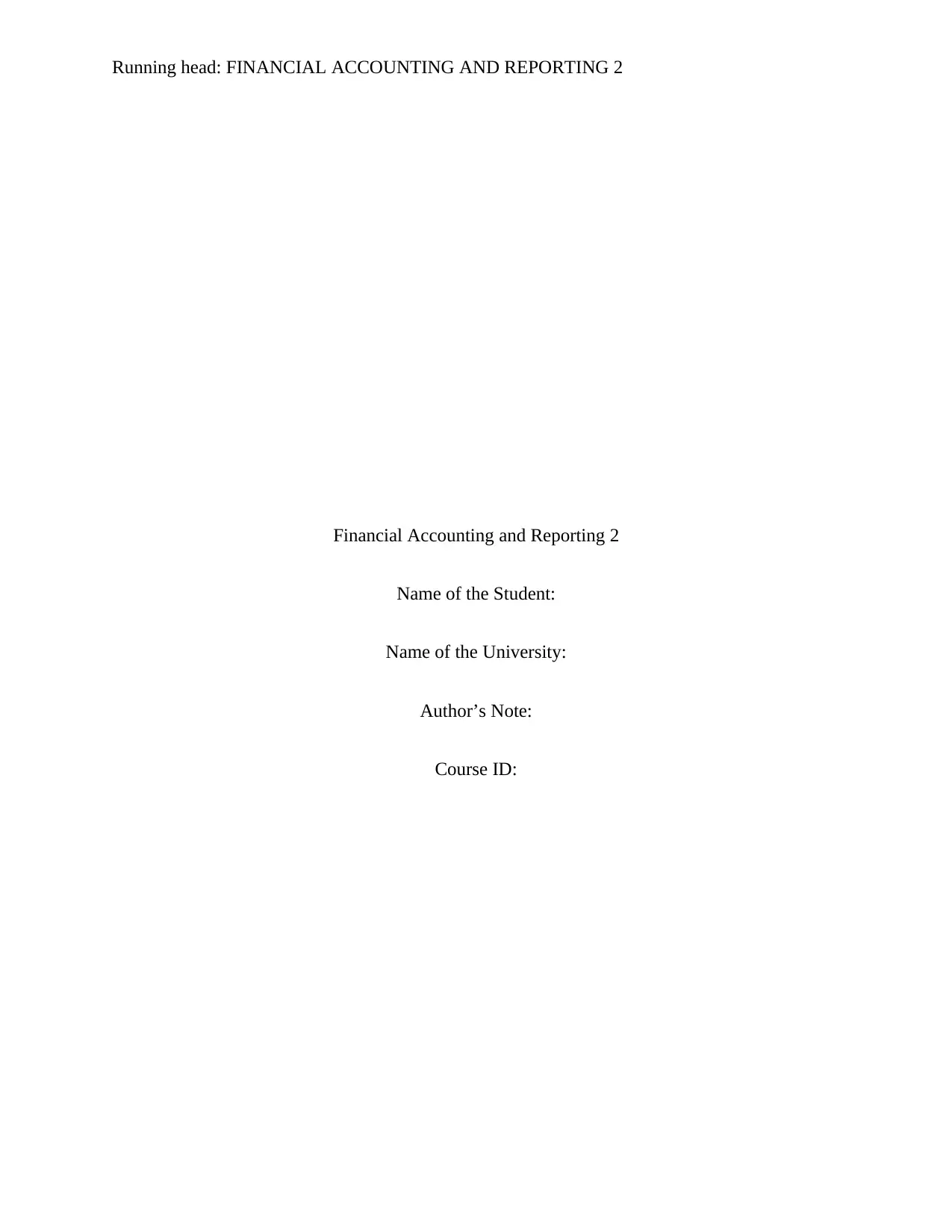
Running head: FINANCIAL ACCOUNTING AND REPORTING 2
Financial Accounting and Reporting 2
Name of the Student:
Name of the University:
Author’s Note:
Course ID:
Financial Accounting and Reporting 2
Name of the Student:
Name of the University:
Author’s Note:
Course ID:
Paraphrase This Document
Need a fresh take? Get an instant paraphrase of this document with our AI Paraphraser
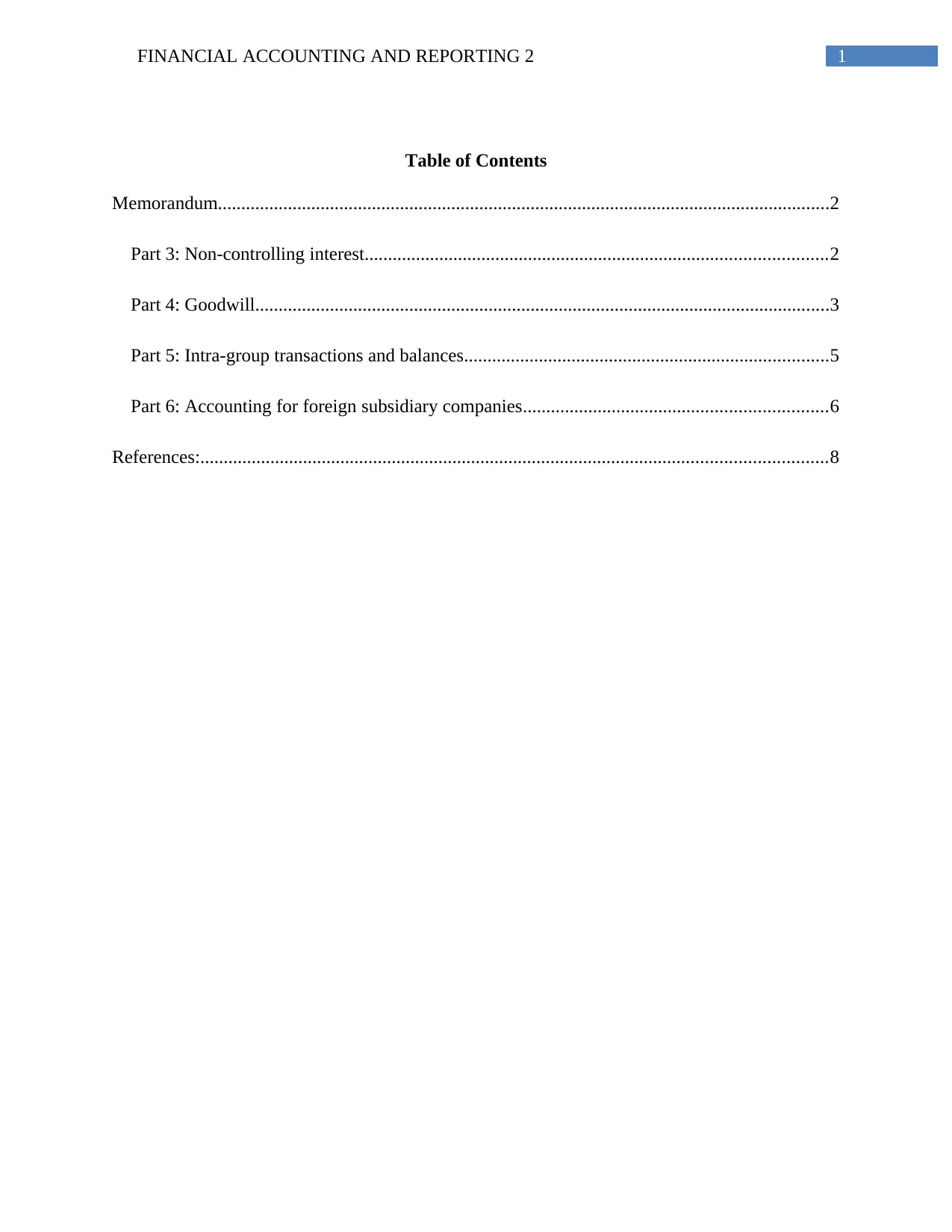
1FINANCIAL ACCOUNTING AND REPORTING 2
Table of Contents
Memorandum...................................................................................................................................2
Part 3: Non-controlling interest...................................................................................................2
Part 4: Goodwill...........................................................................................................................3
Part 5: Intra-group transactions and balances..............................................................................5
Part 6: Accounting for foreign subsidiary companies.................................................................6
References:......................................................................................................................................8
Table of Contents
Memorandum...................................................................................................................................2
Part 3: Non-controlling interest...................................................................................................2
Part 4: Goodwill...........................................................................................................................3
Part 5: Intra-group transactions and balances..............................................................................5
Part 6: Accounting for foreign subsidiary companies.................................................................6
References:......................................................................................................................................8
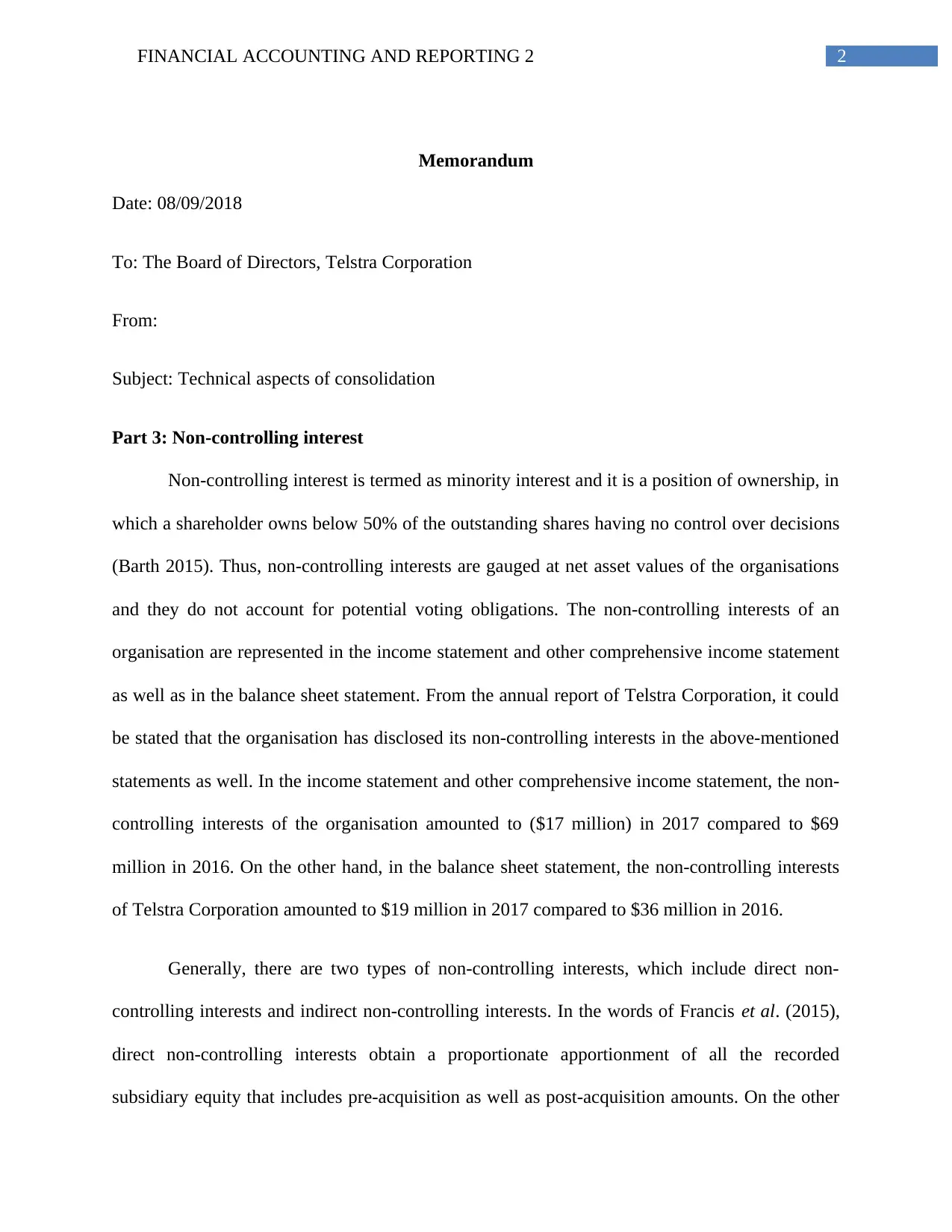
2FINANCIAL ACCOUNTING AND REPORTING 2
Memorandum
Date: 08/09/2018
To: The Board of Directors, Telstra Corporation
From:
Subject: Technical aspects of consolidation
Part 3: Non-controlling interest
Non-controlling interest is termed as minority interest and it is a position of ownership, in
which a shareholder owns below 50% of the outstanding shares having no control over decisions
(Barth 2015). Thus, non-controlling interests are gauged at net asset values of the organisations
and they do not account for potential voting obligations. The non-controlling interests of an
organisation are represented in the income statement and other comprehensive income statement
as well as in the balance sheet statement. From the annual report of Telstra Corporation, it could
be stated that the organisation has disclosed its non-controlling interests in the above-mentioned
statements as well. In the income statement and other comprehensive income statement, the non-
controlling interests of the organisation amounted to ($17 million) in 2017 compared to $69
million in 2016. On the other hand, in the balance sheet statement, the non-controlling interests
of Telstra Corporation amounted to $19 million in 2017 compared to $36 million in 2016.
Generally, there are two types of non-controlling interests, which include direct non-
controlling interests and indirect non-controlling interests. In the words of Francis et al. (2015),
direct non-controlling interests obtain a proportionate apportionment of all the recorded
subsidiary equity that includes pre-acquisition as well as post-acquisition amounts. On the other
Memorandum
Date: 08/09/2018
To: The Board of Directors, Telstra Corporation
From:
Subject: Technical aspects of consolidation
Part 3: Non-controlling interest
Non-controlling interest is termed as minority interest and it is a position of ownership, in
which a shareholder owns below 50% of the outstanding shares having no control over decisions
(Barth 2015). Thus, non-controlling interests are gauged at net asset values of the organisations
and they do not account for potential voting obligations. The non-controlling interests of an
organisation are represented in the income statement and other comprehensive income statement
as well as in the balance sheet statement. From the annual report of Telstra Corporation, it could
be stated that the organisation has disclosed its non-controlling interests in the above-mentioned
statements as well. In the income statement and other comprehensive income statement, the non-
controlling interests of the organisation amounted to ($17 million) in 2017 compared to $69
million in 2016. On the other hand, in the balance sheet statement, the non-controlling interests
of Telstra Corporation amounted to $19 million in 2017 compared to $36 million in 2016.
Generally, there are two types of non-controlling interests, which include direct non-
controlling interests and indirect non-controlling interests. In the words of Francis et al. (2015),
direct non-controlling interests obtain a proportionate apportionment of all the recorded
subsidiary equity that includes pre-acquisition as well as post-acquisition amounts. On the other
⊘ This is a preview!⊘
Do you want full access?
Subscribe today to unlock all pages.

Trusted by 1+ million students worldwide
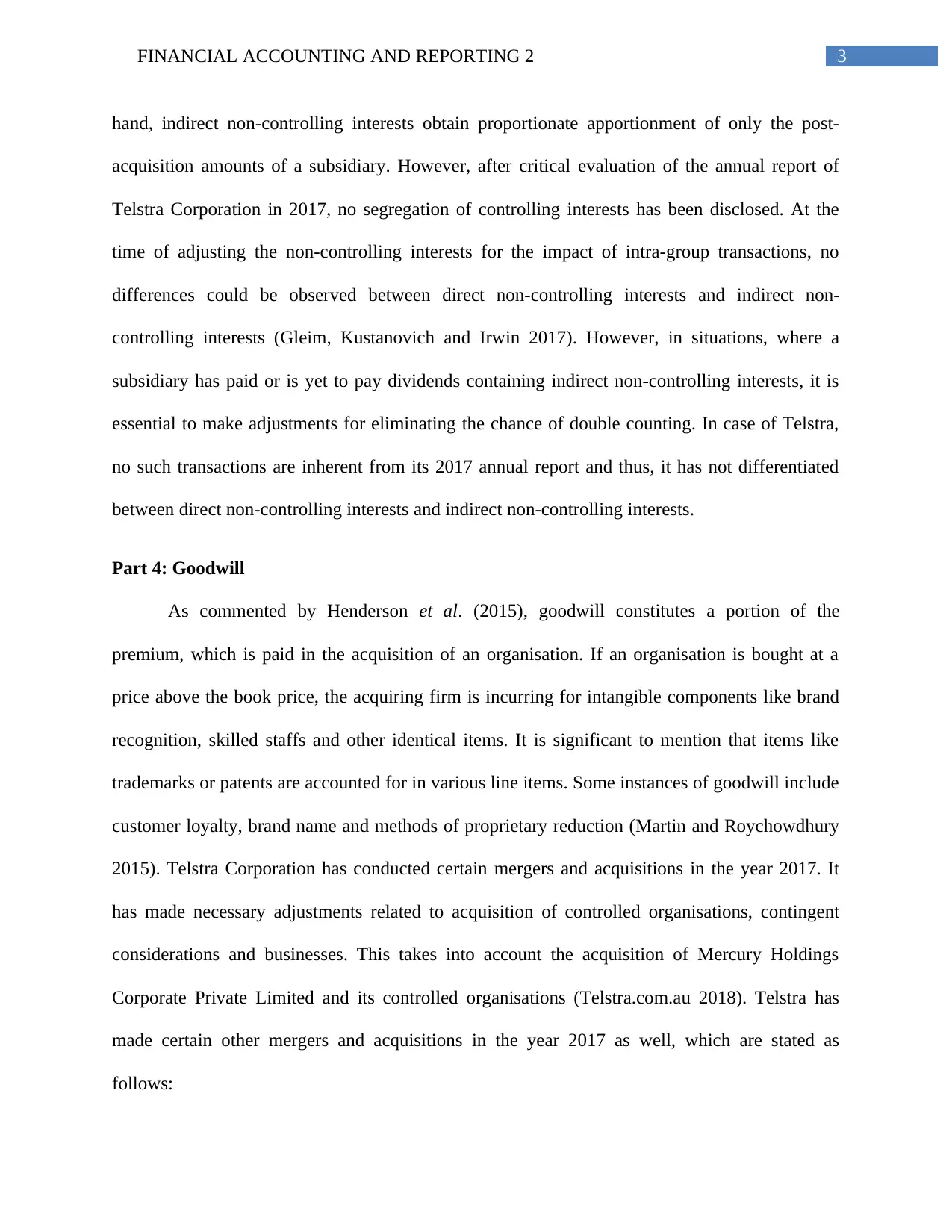
3FINANCIAL ACCOUNTING AND REPORTING 2
hand, indirect non-controlling interests obtain proportionate apportionment of only the post-
acquisition amounts of a subsidiary. However, after critical evaluation of the annual report of
Telstra Corporation in 2017, no segregation of controlling interests has been disclosed. At the
time of adjusting the non-controlling interests for the impact of intra-group transactions, no
differences could be observed between direct non-controlling interests and indirect non-
controlling interests (Gleim, Kustanovich and Irwin 2017). However, in situations, where a
subsidiary has paid or is yet to pay dividends containing indirect non-controlling interests, it is
essential to make adjustments for eliminating the chance of double counting. In case of Telstra,
no such transactions are inherent from its 2017 annual report and thus, it has not differentiated
between direct non-controlling interests and indirect non-controlling interests.
Part 4: Goodwill
As commented by Henderson et al. (2015), goodwill constitutes a portion of the
premium, which is paid in the acquisition of an organisation. If an organisation is bought at a
price above the book price, the acquiring firm is incurring for intangible components like brand
recognition, skilled staffs and other identical items. It is significant to mention that items like
trademarks or patents are accounted for in various line items. Some instances of goodwill include
customer loyalty, brand name and methods of proprietary reduction (Martin and Roychowdhury
2015). Telstra Corporation has conducted certain mergers and acquisitions in the year 2017. It
has made necessary adjustments related to acquisition of controlled organisations, contingent
considerations and businesses. This takes into account the acquisition of Mercury Holdings
Corporate Private Limited and its controlled organisations (Telstra.com.au 2018). Telstra has
made certain other mergers and acquisitions in the year 2017 as well, which are stated as
follows:
hand, indirect non-controlling interests obtain proportionate apportionment of only the post-
acquisition amounts of a subsidiary. However, after critical evaluation of the annual report of
Telstra Corporation in 2017, no segregation of controlling interests has been disclosed. At the
time of adjusting the non-controlling interests for the impact of intra-group transactions, no
differences could be observed between direct non-controlling interests and indirect non-
controlling interests (Gleim, Kustanovich and Irwin 2017). However, in situations, where a
subsidiary has paid or is yet to pay dividends containing indirect non-controlling interests, it is
essential to make adjustments for eliminating the chance of double counting. In case of Telstra,
no such transactions are inherent from its 2017 annual report and thus, it has not differentiated
between direct non-controlling interests and indirect non-controlling interests.
Part 4: Goodwill
As commented by Henderson et al. (2015), goodwill constitutes a portion of the
premium, which is paid in the acquisition of an organisation. If an organisation is bought at a
price above the book price, the acquiring firm is incurring for intangible components like brand
recognition, skilled staffs and other identical items. It is significant to mention that items like
trademarks or patents are accounted for in various line items. Some instances of goodwill include
customer loyalty, brand name and methods of proprietary reduction (Martin and Roychowdhury
2015). Telstra Corporation has conducted certain mergers and acquisitions in the year 2017. It
has made necessary adjustments related to acquisition of controlled organisations, contingent
considerations and businesses. This takes into account the acquisition of Mercury Holdings
Corporate Private Limited and its controlled organisations (Telstra.com.au 2018). Telstra has
made certain other mergers and acquisitions in the year 2017 as well, which are stated as
follows:
Paraphrase This Document
Need a fresh take? Get an instant paraphrase of this document with our AI Paraphraser
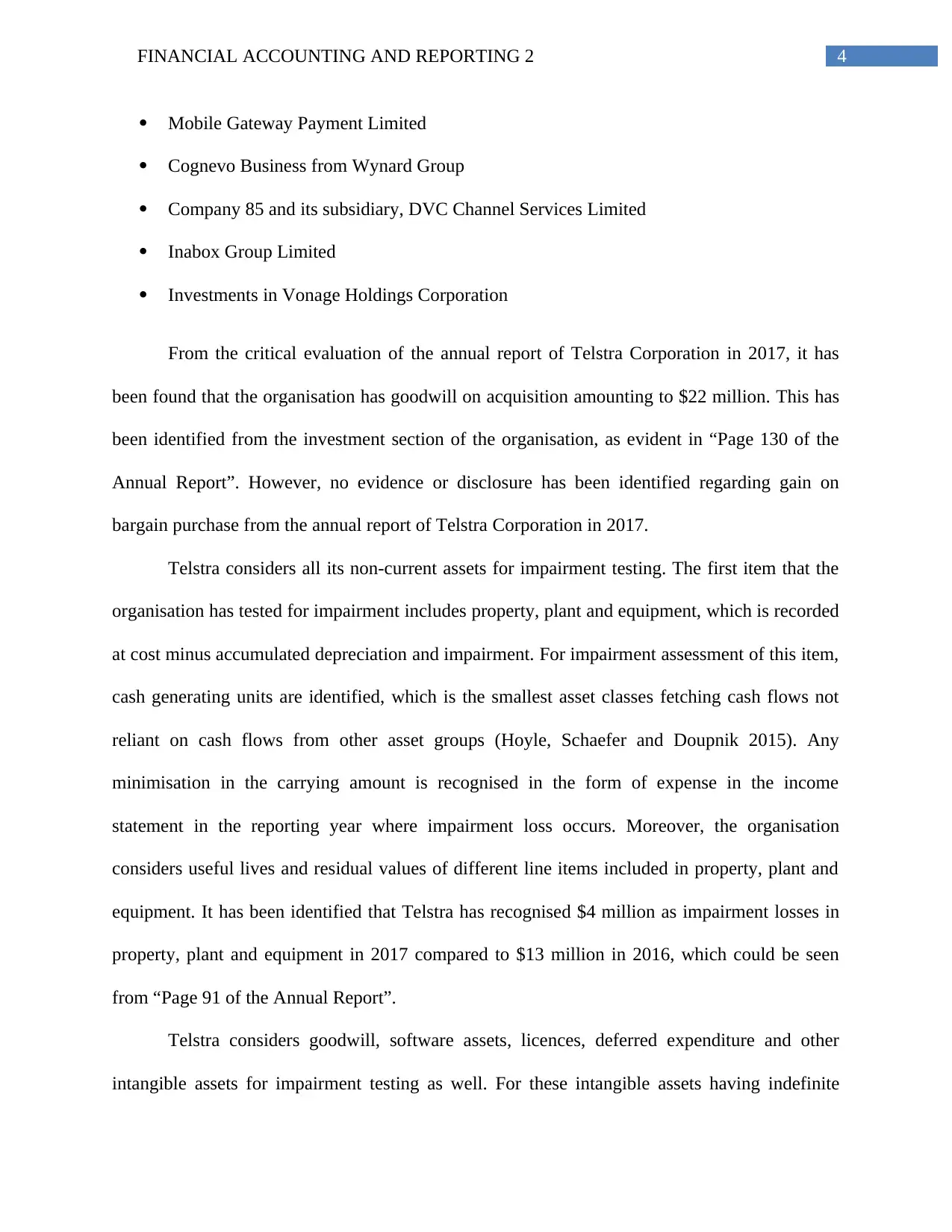
4FINANCIAL ACCOUNTING AND REPORTING 2
Mobile Gateway Payment Limited
Cognevo Business from Wynard Group
Company 85 and its subsidiary, DVC Channel Services Limited
Inabox Group Limited
Investments in Vonage Holdings Corporation
From the critical evaluation of the annual report of Telstra Corporation in 2017, it has
been found that the organisation has goodwill on acquisition amounting to $22 million. This has
been identified from the investment section of the organisation, as evident in “Page 130 of the
Annual Report”. However, no evidence or disclosure has been identified regarding gain on
bargain purchase from the annual report of Telstra Corporation in 2017.
Telstra considers all its non-current assets for impairment testing. The first item that the
organisation has tested for impairment includes property, plant and equipment, which is recorded
at cost minus accumulated depreciation and impairment. For impairment assessment of this item,
cash generating units are identified, which is the smallest asset classes fetching cash flows not
reliant on cash flows from other asset groups (Hoyle, Schaefer and Doupnik 2015). Any
minimisation in the carrying amount is recognised in the form of expense in the income
statement in the reporting year where impairment loss occurs. Moreover, the organisation
considers useful lives and residual values of different line items included in property, plant and
equipment. It has been identified that Telstra has recognised $4 million as impairment losses in
property, plant and equipment in 2017 compared to $13 million in 2016, which could be seen
from “Page 91 of the Annual Report”.
Telstra considers goodwill, software assets, licences, deferred expenditure and other
intangible assets for impairment testing as well. For these intangible assets having indefinite
Mobile Gateway Payment Limited
Cognevo Business from Wynard Group
Company 85 and its subsidiary, DVC Channel Services Limited
Inabox Group Limited
Investments in Vonage Holdings Corporation
From the critical evaluation of the annual report of Telstra Corporation in 2017, it has
been found that the organisation has goodwill on acquisition amounting to $22 million. This has
been identified from the investment section of the organisation, as evident in “Page 130 of the
Annual Report”. However, no evidence or disclosure has been identified regarding gain on
bargain purchase from the annual report of Telstra Corporation in 2017.
Telstra considers all its non-current assets for impairment testing. The first item that the
organisation has tested for impairment includes property, plant and equipment, which is recorded
at cost minus accumulated depreciation and impairment. For impairment assessment of this item,
cash generating units are identified, which is the smallest asset classes fetching cash flows not
reliant on cash flows from other asset groups (Hoyle, Schaefer and Doupnik 2015). Any
minimisation in the carrying amount is recognised in the form of expense in the income
statement in the reporting year where impairment loss occurs. Moreover, the organisation
considers useful lives and residual values of different line items included in property, plant and
equipment. It has been identified that Telstra has recognised $4 million as impairment losses in
property, plant and equipment in 2017 compared to $13 million in 2016, which could be seen
from “Page 91 of the Annual Report”.
Telstra considers goodwill, software assets, licences, deferred expenditure and other
intangible assets for impairment testing as well. For these intangible assets having indefinite
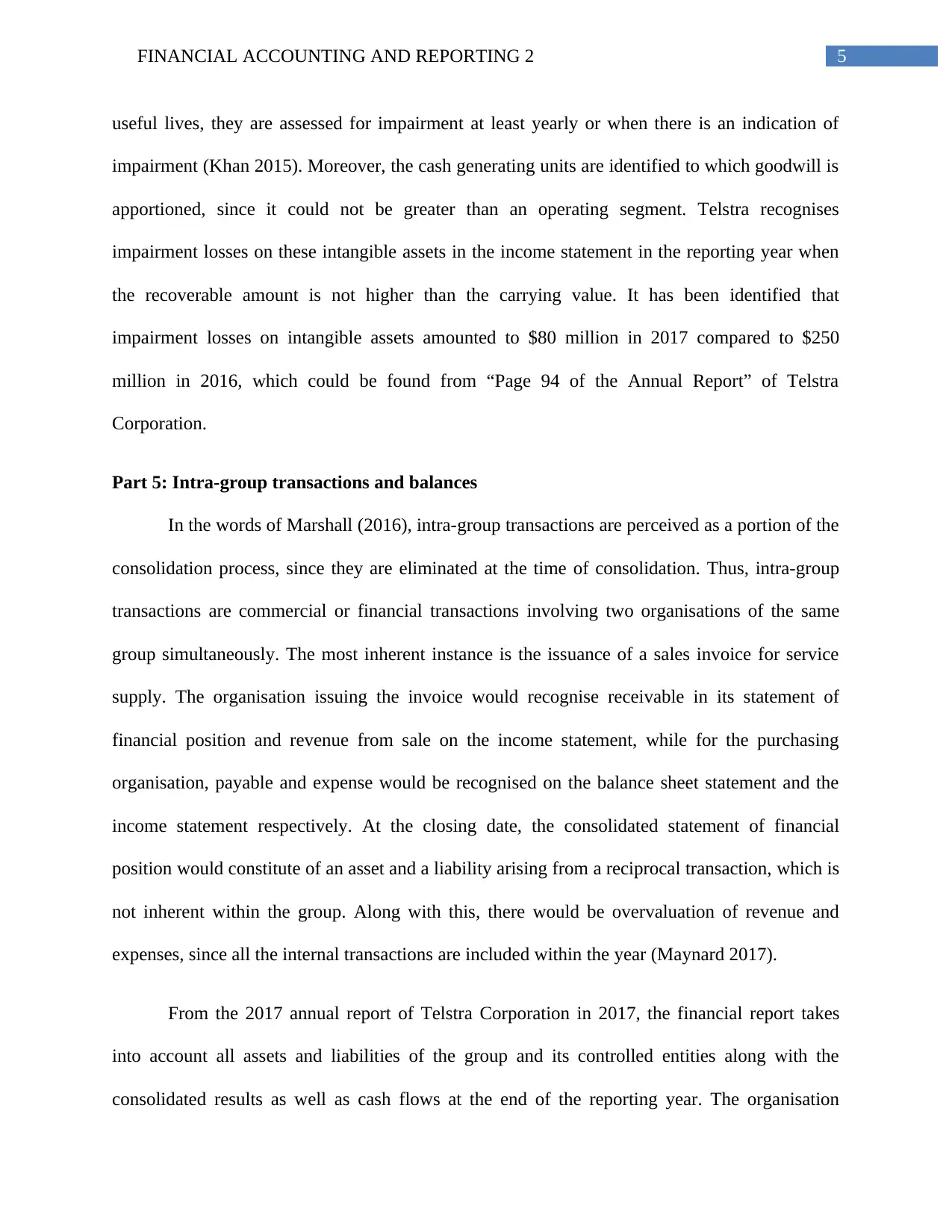
5FINANCIAL ACCOUNTING AND REPORTING 2
useful lives, they are assessed for impairment at least yearly or when there is an indication of
impairment (Khan 2015). Moreover, the cash generating units are identified to which goodwill is
apportioned, since it could not be greater than an operating segment. Telstra recognises
impairment losses on these intangible assets in the income statement in the reporting year when
the recoverable amount is not higher than the carrying value. It has been identified that
impairment losses on intangible assets amounted to $80 million in 2017 compared to $250
million in 2016, which could be found from “Page 94 of the Annual Report” of Telstra
Corporation.
Part 5: Intra-group transactions and balances
In the words of Marshall (2016), intra-group transactions are perceived as a portion of the
consolidation process, since they are eliminated at the time of consolidation. Thus, intra-group
transactions are commercial or financial transactions involving two organisations of the same
group simultaneously. The most inherent instance is the issuance of a sales invoice for service
supply. The organisation issuing the invoice would recognise receivable in its statement of
financial position and revenue from sale on the income statement, while for the purchasing
organisation, payable and expense would be recognised on the balance sheet statement and the
income statement respectively. At the closing date, the consolidated statement of financial
position would constitute of an asset and a liability arising from a reciprocal transaction, which is
not inherent within the group. Along with this, there would be overvaluation of revenue and
expenses, since all the internal transactions are included within the year (Maynard 2017).
From the 2017 annual report of Telstra Corporation in 2017, the financial report takes
into account all assets and liabilities of the group and its controlled entities along with the
consolidated results as well as cash flows at the end of the reporting year. The organisation
useful lives, they are assessed for impairment at least yearly or when there is an indication of
impairment (Khan 2015). Moreover, the cash generating units are identified to which goodwill is
apportioned, since it could not be greater than an operating segment. Telstra recognises
impairment losses on these intangible assets in the income statement in the reporting year when
the recoverable amount is not higher than the carrying value. It has been identified that
impairment losses on intangible assets amounted to $80 million in 2017 compared to $250
million in 2016, which could be found from “Page 94 of the Annual Report” of Telstra
Corporation.
Part 5: Intra-group transactions and balances
In the words of Marshall (2016), intra-group transactions are perceived as a portion of the
consolidation process, since they are eliminated at the time of consolidation. Thus, intra-group
transactions are commercial or financial transactions involving two organisations of the same
group simultaneously. The most inherent instance is the issuance of a sales invoice for service
supply. The organisation issuing the invoice would recognise receivable in its statement of
financial position and revenue from sale on the income statement, while for the purchasing
organisation, payable and expense would be recognised on the balance sheet statement and the
income statement respectively. At the closing date, the consolidated statement of financial
position would constitute of an asset and a liability arising from a reciprocal transaction, which is
not inherent within the group. Along with this, there would be overvaluation of revenue and
expenses, since all the internal transactions are included within the year (Maynard 2017).
From the 2017 annual report of Telstra Corporation in 2017, the financial report takes
into account all assets and liabilities of the group and its controlled entities along with the
consolidated results as well as cash flows at the end of the reporting year. The organisation
⊘ This is a preview!⊘
Do you want full access?
Subscribe today to unlock all pages.

Trusted by 1+ million students worldwide
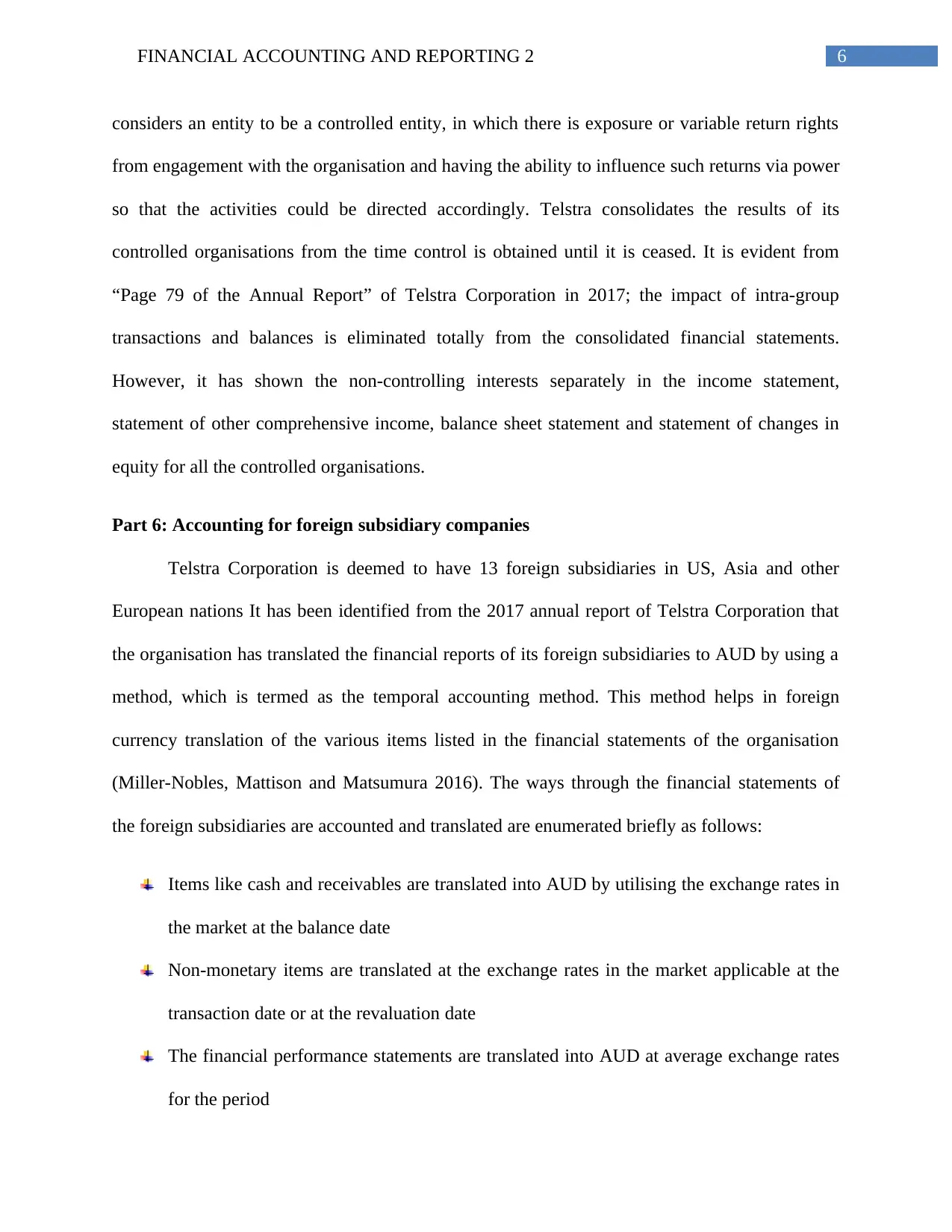
6FINANCIAL ACCOUNTING AND REPORTING 2
considers an entity to be a controlled entity, in which there is exposure or variable return rights
from engagement with the organisation and having the ability to influence such returns via power
so that the activities could be directed accordingly. Telstra consolidates the results of its
controlled organisations from the time control is obtained until it is ceased. It is evident from
“Page 79 of the Annual Report” of Telstra Corporation in 2017; the impact of intra-group
transactions and balances is eliminated totally from the consolidated financial statements.
However, it has shown the non-controlling interests separately in the income statement,
statement of other comprehensive income, balance sheet statement and statement of changes in
equity for all the controlled organisations.
Part 6: Accounting for foreign subsidiary companies
Telstra Corporation is deemed to have 13 foreign subsidiaries in US, Asia and other
European nations It has been identified from the 2017 annual report of Telstra Corporation that
the organisation has translated the financial reports of its foreign subsidiaries to AUD by using a
method, which is termed as the temporal accounting method. This method helps in foreign
currency translation of the various items listed in the financial statements of the organisation
(Miller-Nobles, Mattison and Matsumura 2016). The ways through the financial statements of
the foreign subsidiaries are accounted and translated are enumerated briefly as follows:
Items like cash and receivables are translated into AUD by utilising the exchange rates in
the market at the balance date
Non-monetary items are translated at the exchange rates in the market applicable at the
transaction date or at the revaluation date
The financial performance statements are translated into AUD at average exchange rates
for the period
considers an entity to be a controlled entity, in which there is exposure or variable return rights
from engagement with the organisation and having the ability to influence such returns via power
so that the activities could be directed accordingly. Telstra consolidates the results of its
controlled organisations from the time control is obtained until it is ceased. It is evident from
“Page 79 of the Annual Report” of Telstra Corporation in 2017; the impact of intra-group
transactions and balances is eliminated totally from the consolidated financial statements.
However, it has shown the non-controlling interests separately in the income statement,
statement of other comprehensive income, balance sheet statement and statement of changes in
equity for all the controlled organisations.
Part 6: Accounting for foreign subsidiary companies
Telstra Corporation is deemed to have 13 foreign subsidiaries in US, Asia and other
European nations It has been identified from the 2017 annual report of Telstra Corporation that
the organisation has translated the financial reports of its foreign subsidiaries to AUD by using a
method, which is termed as the temporal accounting method. This method helps in foreign
currency translation of the various items listed in the financial statements of the organisation
(Miller-Nobles, Mattison and Matsumura 2016). The ways through the financial statements of
the foreign subsidiaries are accounted and translated are enumerated briefly as follows:
Items like cash and receivables are translated into AUD by utilising the exchange rates in
the market at the balance date
Non-monetary items are translated at the exchange rates in the market applicable at the
transaction date or at the revaluation date
The financial performance statements are translated into AUD at average exchange rates
for the period
Paraphrase This Document
Need a fresh take? Get an instant paraphrase of this document with our AI Paraphraser
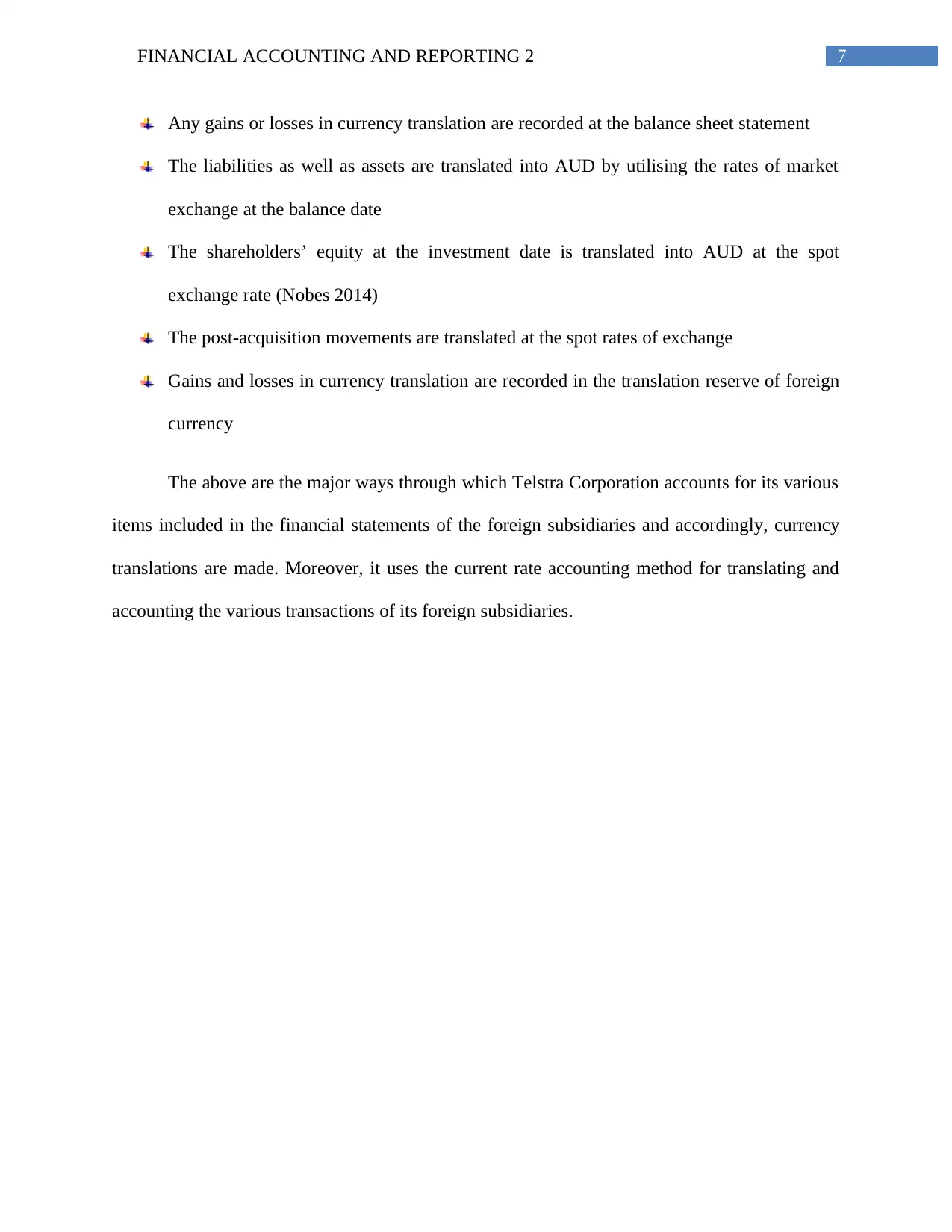
7FINANCIAL ACCOUNTING AND REPORTING 2
Any gains or losses in currency translation are recorded at the balance sheet statement
The liabilities as well as assets are translated into AUD by utilising the rates of market
exchange at the balance date
The shareholders’ equity at the investment date is translated into AUD at the spot
exchange rate (Nobes 2014)
The post-acquisition movements are translated at the spot rates of exchange
Gains and losses in currency translation are recorded in the translation reserve of foreign
currency
The above are the major ways through which Telstra Corporation accounts for its various
items included in the financial statements of the foreign subsidiaries and accordingly, currency
translations are made. Moreover, it uses the current rate accounting method for translating and
accounting the various transactions of its foreign subsidiaries.
Any gains or losses in currency translation are recorded at the balance sheet statement
The liabilities as well as assets are translated into AUD by utilising the rates of market
exchange at the balance date
The shareholders’ equity at the investment date is translated into AUD at the spot
exchange rate (Nobes 2014)
The post-acquisition movements are translated at the spot rates of exchange
Gains and losses in currency translation are recorded in the translation reserve of foreign
currency
The above are the major ways through which Telstra Corporation accounts for its various
items included in the financial statements of the foreign subsidiaries and accordingly, currency
translations are made. Moreover, it uses the current rate accounting method for translating and
accounting the various transactions of its foreign subsidiaries.
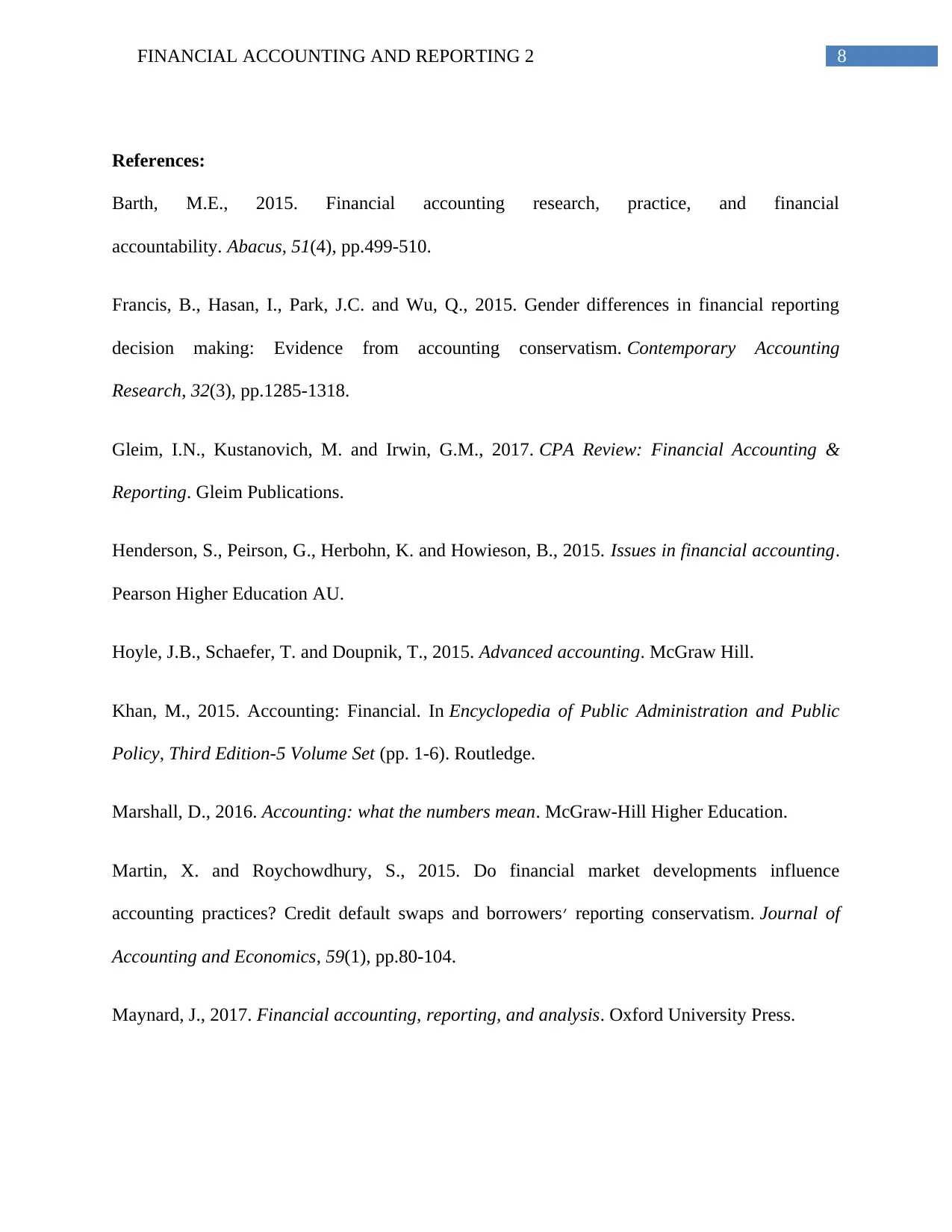
8FINANCIAL ACCOUNTING AND REPORTING 2
References:
Barth, M.E., 2015. Financial accounting research, practice, and financial
accountability. Abacus, 51(4), pp.499-510.
Francis, B., Hasan, I., Park, J.C. and Wu, Q., 2015. Gender differences in financial reporting
decision making: Evidence from accounting conservatism. Contemporary Accounting
Research, 32(3), pp.1285-1318.
Gleim, I.N., Kustanovich, M. and Irwin, G.M., 2017. CPA Review: Financial Accounting &
Reporting. Gleim Publications.
Henderson, S., Peirson, G., Herbohn, K. and Howieson, B., 2015. Issues in financial accounting.
Pearson Higher Education AU.
Hoyle, J.B., Schaefer, T. and Doupnik, T., 2015. Advanced accounting. McGraw Hill.
Khan, M., 2015. Accounting: Financial. In Encyclopedia of Public Administration and Public
Policy, Third Edition-5 Volume Set (pp. 1-6). Routledge.
Marshall, D., 2016. Accounting: what the numbers mean. McGraw-Hill Higher Education.
Martin, X. and Roychowdhury, S., 2015. Do financial market developments influence
accounting practices? Credit default swaps and borrowers׳ reporting conservatism. Journal of
Accounting and Economics, 59(1), pp.80-104.
Maynard, J., 2017. Financial accounting, reporting, and analysis. Oxford University Press.
References:
Barth, M.E., 2015. Financial accounting research, practice, and financial
accountability. Abacus, 51(4), pp.499-510.
Francis, B., Hasan, I., Park, J.C. and Wu, Q., 2015. Gender differences in financial reporting
decision making: Evidence from accounting conservatism. Contemporary Accounting
Research, 32(3), pp.1285-1318.
Gleim, I.N., Kustanovich, M. and Irwin, G.M., 2017. CPA Review: Financial Accounting &
Reporting. Gleim Publications.
Henderson, S., Peirson, G., Herbohn, K. and Howieson, B., 2015. Issues in financial accounting.
Pearson Higher Education AU.
Hoyle, J.B., Schaefer, T. and Doupnik, T., 2015. Advanced accounting. McGraw Hill.
Khan, M., 2015. Accounting: Financial. In Encyclopedia of Public Administration and Public
Policy, Third Edition-5 Volume Set (pp. 1-6). Routledge.
Marshall, D., 2016. Accounting: what the numbers mean. McGraw-Hill Higher Education.
Martin, X. and Roychowdhury, S., 2015. Do financial market developments influence
accounting practices? Credit default swaps and borrowers׳ reporting conservatism. Journal of
Accounting and Economics, 59(1), pp.80-104.
Maynard, J., 2017. Financial accounting, reporting, and analysis. Oxford University Press.
⊘ This is a preview!⊘
Do you want full access?
Subscribe today to unlock all pages.

Trusted by 1+ million students worldwide
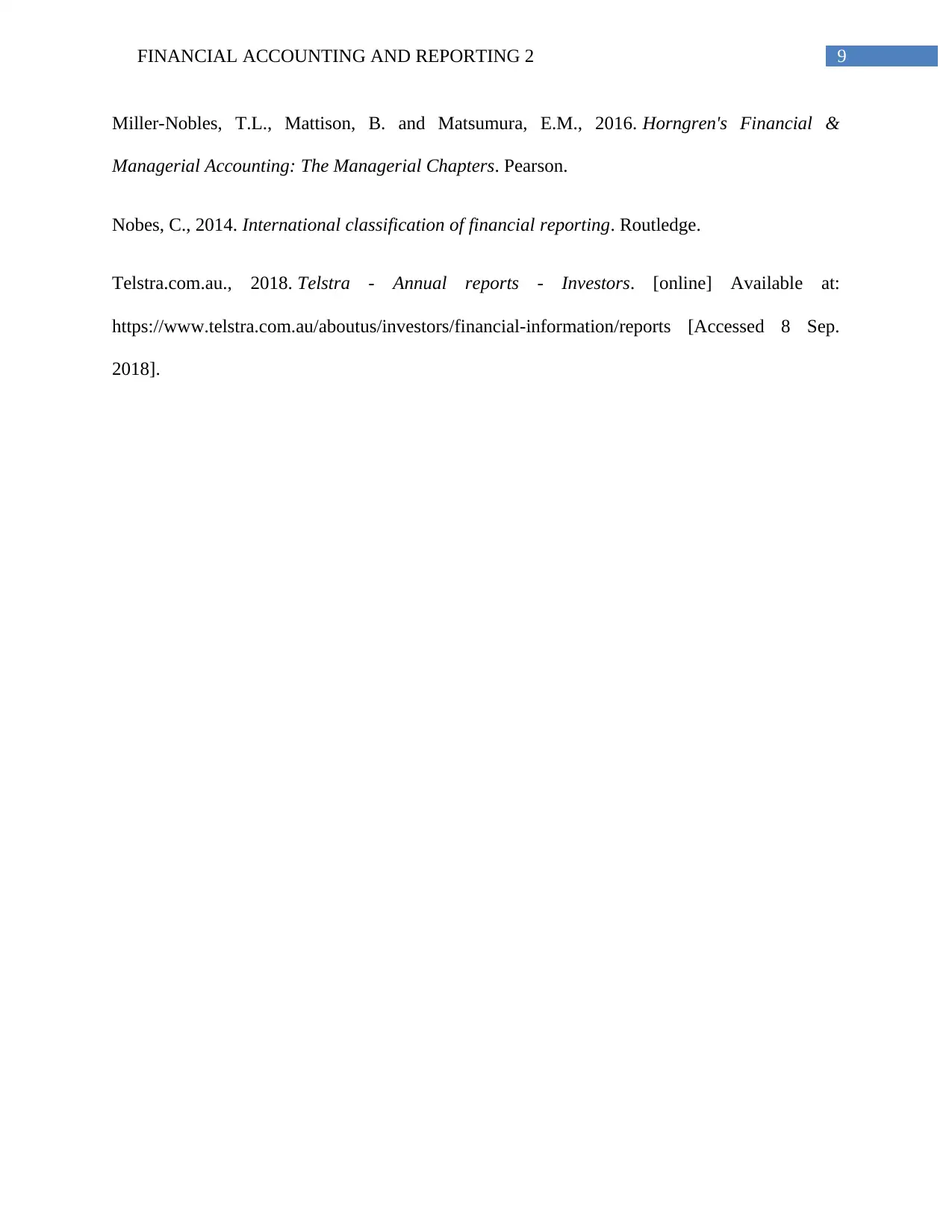
9FINANCIAL ACCOUNTING AND REPORTING 2
Miller-Nobles, T.L., Mattison, B. and Matsumura, E.M., 2016. Horngren's Financial &
Managerial Accounting: The Managerial Chapters. Pearson.
Nobes, C., 2014. International classification of financial reporting. Routledge.
Telstra.com.au., 2018. Telstra - Annual reports - Investors. [online] Available at:
https://www.telstra.com.au/aboutus/investors/financial-information/reports [Accessed 8 Sep.
2018].
Miller-Nobles, T.L., Mattison, B. and Matsumura, E.M., 2016. Horngren's Financial &
Managerial Accounting: The Managerial Chapters. Pearson.
Nobes, C., 2014. International classification of financial reporting. Routledge.
Telstra.com.au., 2018. Telstra - Annual reports - Investors. [online] Available at:
https://www.telstra.com.au/aboutus/investors/financial-information/reports [Accessed 8 Sep.
2018].
1 out of 10
Related Documents
Your All-in-One AI-Powered Toolkit for Academic Success.
+13062052269
info@desklib.com
Available 24*7 on WhatsApp / Email
![[object Object]](/_next/static/media/star-bottom.7253800d.svg)
Unlock your academic potential
Copyright © 2020–2025 A2Z Services. All Rights Reserved. Developed and managed by ZUCOL.




